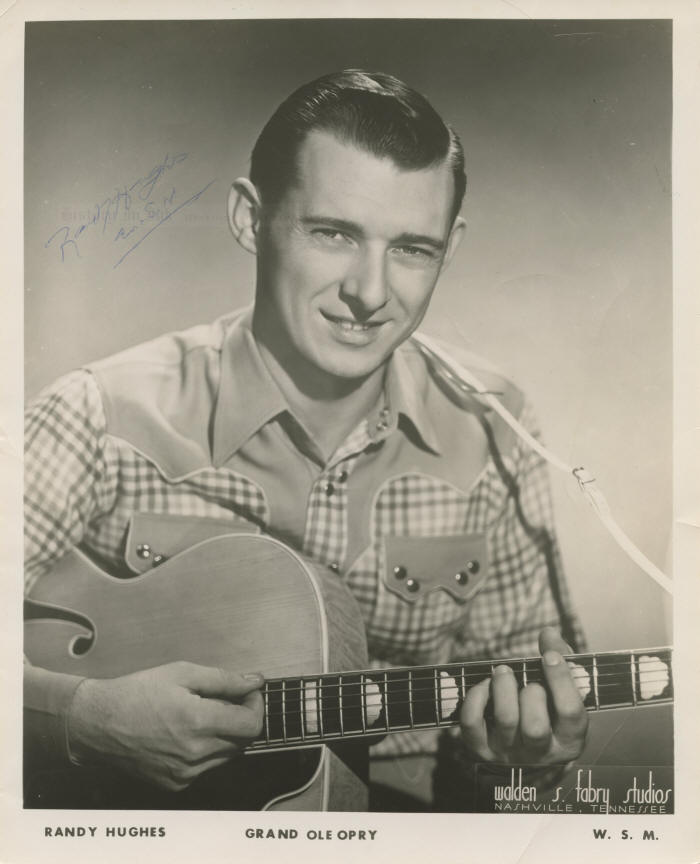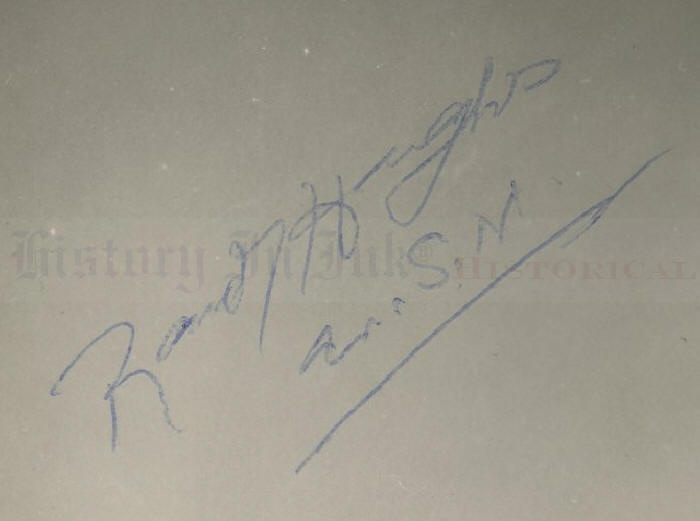

1306527
Randy Hughes
Extremely rare signed photo of Patsy Cline’s manager, the pilot of the plane in which she died
Ramsey D. “Randy” Hughes, 1928–1963. Country music performer and businessman. Vintage glossy 8” x 10” photograph signed Randy Hughes / W.S.M.
This is an extremely rare signed photograph of Hughes, who flew the plane in which he, the legendary Patsy Cline, and two other Grand Ole Opry stars, Cowboy Copas and Hawkshaw Hawkins, died on March 5, 1963. Our search of auction records shows no sales of Hughes’s autograph material since 1975. We found only one Hughes item even listed at auction, Hughes’s 1963 pocket diary. It contained Cline’s telephone number but, as far as we could tell, was not signed.
This photo has never been on the autograph market before. It comes from a collection of vintage signed photographs of country music stars owned by the president of recording artist George Morgan’s fan club in the mid-1950s. The photograph, a publicity photo for Nashville radio station WSM, the home of the Opry, shows a smiling Hughes wearing a western shirt playing a guitar. Hughes has signed it and added the station’s call letters in blue ballpoint in a blank area at the upper left.
Hughes, who was 34 at the time of his death, was Copas’s son-in-law and, perhaps more significantly, Cline’s manager. Hughes was himself a capable entertainer who played in the band behind Copas and Cline. YouTube has several of his recordings, and videos of Copas show Hughes singing and playing guitar in the band. But Hughes decided that he could do more in country music by managing others’ careers. He bought a small, single-engine Piper Comanche airplane that he bought to attract clients and to fly stars from one show to another.
Hughes was flying the Piper to return Cline, Copas, and Hawkins home from performing three standing-room-only shows as a benefit in Kansas City, Missouri, on March 3. Hughes was fearless—in a car he was sometimes known as “The Hundred Mile an Hour Man.” Although he was not trained to fly with instruments, Hughes took off despite the advice of the airfield manager in Dyersburg, Tennessee, where he landed to obtain weather information for the rest of the trip, not to fly into the storm that had buffeted Nashville all day. He relied instead on the observations of his wife, Kathy, who was at home in Nashville and had told him by phone that the rain had stopped and that the sun appeared to be setting in the west. Unfortunately, she did not know that she was in the eye of the storm. When the plane encountered the storm, it dove and crashed nose down in a field near Camden, Tennessee, some 90 miles outside of Nashville. All four of its passengers were killed instantaneously.
The National Transportation Safety Board report said that Hughes “received a thorough weather briefing based on reports of existing and forecast terminal and area weather . . . and current advisories to light aircraft” and was “informed that the en route weather was unfavorable and that the destination weather was below VFR minima with further deterioration indicated before any improving trends could be expected.” VFR means “visual flight rules,” and VFR minima are the boundary criteria between instrument and visual flight conditions and are defined by visibility, cloud ceilings, and cloud clearances. After Hughes received the weather briefing, the report said, he “talked with his wife in Nashville by telephone, and she informed him that the sun was shining in Nashville. [He] then indicated his intention to continue the flight and would return if he found it necessary.” He received one last weather report while taxiing to the runway. It was his last radio contact with ground control. About 6:30 p.m., a witness near Camden heard and then saw the plane “as it descended the low overcast in an estimated 45° nose-down dive, and then heard a dull crash.”
The Nashville Banner reported that the plane apparently struck a large tree before hitting the ground, that pieces of the yellow plane were hanging in the tree, and that aircraft parts and bits of human flesh were scattered over a 60-yard area. When asked whether all four bodies had been recovered, a local civil defense official replied, “There’s not enough to count. . . . They’re all in small pieces.” Cline’s bloody slip was found hanging in a tree.
The cloud ceiling was at 500 feet. The NTSB investigation determined that the plane was intact and that the engine was “developing substantial power at initial impact with trees. There was no evidence of preimpact failure or malfunction.” Furthermore, it said, post-mortem tests showed nothing that could have been a factor in the accident. Thus, the NTSB attributed the crash to the “[j]udgment of the pilot in initiating flight in the existing conditions” and to the fact that a “[n]on-instrument pilot attempted visual flight in adverse weather conditions, resulting in a loss of control.”
This photograph is in fine to very fine condition. It has scattered minor surface creasing, which does not detract from its overall quality.
Particularly given Hughes’s association with both Copas and Cline, collectors and fans of Cline and of country music history should take care not to let this photograph get away. This photo has been in a private collection for more than 50 years, and there is no certainty that another one will ever come on the market.
Unframed.
_____________
This item has been sold, but
click here to see other
American History items
that we are offering.



